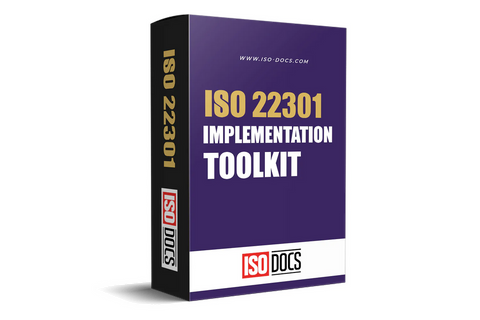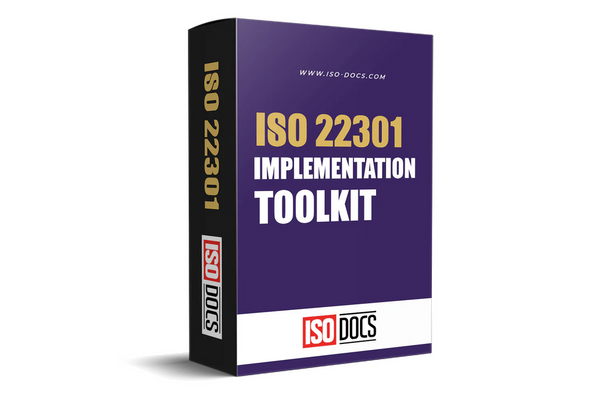ISO 22301 : Non Conformity and Corrective Action Procedure
ISO 22301, the international standard for Business Continuity Management Systems (BCMS), plays a pivotal role in helping organizations fortify their resilience against disruptions. Among its key components, the Non-Conformity and Corrective Action Procedure stand as pillars of proactive risk management. This procedure ensures that deviations from established business continuity standards are identified, addressed, and rectified systematically.
In essence, the Non-Conformity and Corrective Action Procedure provide a framework for organizations to not only detect discrepancies between actual and planned performance but also to respond effectively. By adhering to these guidelines, businesses can cultivate a culture of continual improvement, bolstering their ability to navigate unforeseen challenges with agility and precision.
Importance of ISO 22301 : Non Conformity and Corrective Action Procedure
Risk Mitigation:
- ISO 22301's Non-Conformity and Corrective Action Procedure is crucial for identifying and mitigating risks to an organization's business continuity.
- It establishes a systematic approach to recognize non-conformities in processes and systems, helping to prevent potential disruptions.
Continuous Improvement:
- The procedure promotes a culture of continuous improvement by addressing non-conformities promptly and effectively.
- Through corrective actions, organizations can learn from incidents, refine processes, and enhance their overall business continuity management system.
Compliance Assurance:
- Adherence to ISO 22301 standards, including the Non-Conformity and Corrective Action Procedure, ensures compliance with international best practices in business continuity.
- Compliance not only enhances organizational resilience but also instills confidence in stakeholders and partners.
Enhanced Resilience:
- Rapid identification and correction of non-conformities contribute to heightened resilience in the face of unexpected events or disasters.
- The procedure enables organizations to bounce back swiftly, minimizing downtime and preserving critical functions.
Organizational Learning:
- By systematically addressing non-conformities, the procedure facilitates a learning environment within the organization.
- Insights gained from corrective actions provide valuable data for refining risk assessments, response plans, and overall business continuity strategies.
Customer and Stakeholder Trust:
- Implementing ISO 22301, particularly its Non-Conformity and Corrective Action Procedure, demonstrates a commitment to business continuity and risk management.
- This commitment builds trust among customers, partners, and stakeholders, showcasing an organization's dedication to delivering uninterrupted services.
Cost Reduction:
- Timely identification and resolution of non-conformities prevent potential financial losses associated with business interruptions.
- Proactive corrective actions can lead to cost savings by averting or minimizing the impact of disruptions on operations.
Regulatory Alignment:
- Many industries have specific regulations related to business continuity. ISO 22301 ensures alignment with these regulatory requirements through its comprehensive approach to managing non-conformities.
Effective Communication:
- The procedure fosters clear communication channels within the organization regarding non-conformities and their resolutions.
- This transparency enhances internal collaboration and ensures that everyone is aware of the steps taken to address business continuity issues.
Global Competitiveness:
- Adhering to ISO 22301 standards, including the Non-Conformity and Corrective Action Procedure, enhances an organization's global competitiveness.
- Certification provides a competitive edge in the market, showcasing a commitment to robust business continuity practices that meet international benchmarks.
Key components of ISO 22301 : Non Conformity and Corrective Action Procedure
Non-Conformity Identification:
- Establish a clear process for identifying instances where actual performance deviates from planned business continuity requirements.
- Define criteria for recognizing non-conformities in processes, systems, or documentation.
Documentation and Record Keeping:
- Develop a robust documentation system to record and categorize identified non-conformities.
- Maintain accurate and detailed records to facilitate analysis, trending, and continuous improvement.
Root Cause Analysis:
- Conduct thorough root cause analysis for each identified non-conformity.
- Determine the underlying factors contributing to deviations from established business continuity standards.
Risk Assessment:
- Integrate non-conformity data into the organization's risk assessment process.
- Assess the potential impact of non-conformities on business continuity and prioritize corrective actions accordingly.
Corrective Action Planning:
- Formulate a systematic approach to planning corrective actions, considering the identified root causes.
- Define clear objectives, responsibilities, and timelines for implementing corrective measures.
- Establish effective communication channels for reporting non-conformities and disseminating information about corrective actions.
- Ensure that relevant stakeholders are informed promptly and comprehensively.
Implementation of Corrective Actions:
- Execute corrective actions in a timely and efficient manner.
- Monitor the progress of corrective measures and adjust strategies as needed.
Monitoring and Measurement:
- Implement mechanisms for monitoring the effectiveness of corrective actions.
- Define key performance indicators (KPIs) to measure the success of the corrective action process.
Documentation of Corrective Actions:
- Document all steps taken during the corrective action process.
- Maintain a record of the implemented actions and their outcomes for future reference and auditing.
Review and Evaluation:
- Periodically review the effectiveness of the non-conformity and corrective action procedures.
- Evaluate the overall performance of the business continuity management system and identify opportunities for improvement.
Training and Awareness:
- Provide training to relevant personnel on the non-conformity and corrective action procedures.
- Foster awareness of the importance of proactive identification and resolution of non-conformities throughout the organization.
Continuous Improvement:
- Establish a feedback loop for continuous improvement based on lessons learned from non-conformities.
- Use insights gained from corrective actions to refine policies, procedures, and the overall business continuity management system.
Internal Audits:
- Conduct regular internal audits to assess compliance with the Non-Conformity and Corrective Action Procedure.
- Use audit findings to identify areas for improvement and ensure ongoing adherence to ISO 22301 standards.
Documentation of Lessons Learned:
- Document lessons learned from non-conformities and their resolutions.
- Leverage this information to enhance organizational resilience and prevent similar incidents in the future.
The Benefits of ISO 22301 : Non Conformity and Corrective Action Procedure
Enhanced Business Continuity:
- Identification and correction of non-conformities contribute to a more robust and reliable business continuity management system.
- Organizations are better equipped to anticipate, prevent, and respond to disruptions effectively.
Reduced Operational Downtime:
- Timely identification and correction of non-conformities help minimize operational downtime.
- Swift corrective actions ensure that critical business functions are restored promptly, reducing the impact of disruptions.
Improved Risk Management:
- The procedure integrates non-conformity management into the broader risk management framework.
- Organizations gain a comprehensive understanding of potential threats, allowing for proactive risk mitigation.
Regulatory Compliance:
- Adherence to ISO 22301 standards, including the Non-Conformity and Corrective Action Procedure, ensures compliance with business continuity and risk management regulations.
- This compliance can be crucial for industries with strict regulatory requirements.
Cost Savings:
- Proactive management of non-conformities prevents financial losses associated with business interruptions.
- Effective corrective actions can lead to cost savings by addressing issues before they escalate.
Stakeholder Confidence:
- Implementation of ISO 22301 demonstrates a commitment to sound business continuity practices.
- Stakeholders, including customers, partners, and investors, gain confidence in the organization's ability to navigate disruptions.
Continuous Improvement Culture:
- The procedure fosters a culture of continuous improvement within the organization.
- Insights from non-conformities drive ongoing enhancements to business continuity strategies and processes.
Operational Resilience:
- Robust non-conformity management contributes to increased operational resilience.
- Organizations can adapt more effectively to unforeseen challenges, maintaining a higher level of operational stability.
Improved Decision-Making:
- Data gathered from non-conformity analysis informs better decision-making.
- Decision-makers have access to insights that help refine strategies and allocate resources more effectively.
Effective Communication:
- The procedure establishes clear communication channels for reporting non-conformities and their resolutions.
- Improved communication ensures that relevant stakeholders are informed promptly, facilitating a coordinated response.
Organizational Learning:
- The procedure encourages organizational learning through the systematic analysis of non-conformities.
- Insights gained from corrective actions contribute to the organization's knowledge base and resilience.
Competitive Advantage:
- Certification to ISO 22301, with a robust Non-Conformity and Corrective Action Procedure, provides a competitive edge in the market.
- It demonstrates a commitment to excellence in business continuity management.
Employee Morale and Confidence:
- Employees are more confident and motivated knowing that the organization has effective processes in place to address non-conformities.
- A well-managed business continuity system fosters a sense of security and pride among staff.
Audit Preparedness:
- Organizations with a well-defined Non-Conformity and Corrective Action Procedure are better prepared for internal and external audits.
- Compliance with ISO 22301 standards is readily demonstrable, leading to smoother audit processes.
Conclusion
In conclusion, the ISO 22301: Non-Conformity and Corrective Action Procedure stands as a linchpin in the realm of business continuity management. Its implementation not only ensures adherence to international standards but cultivates a culture of resilience within an organization. By systematically identifying and rectifying non-conformities, this procedure serves as a proactive shield against potential disruptions, mitigating risks and minimizing operational downtime.
The benefits extend beyond mere compliance, encompassing improved decision-making, stakeholder confidence, and a competitive edge in the market. As a continuous improvement tool, it fosters organizational learning, contributing to enhanced operational stability and the ability to navigate unforeseen challenges adeptly. In essence, the Non-Conformity and Corrective Action Procedure under ISO 22301 not only safeguards an organization's continuity but positions it on a trajectory of sustained excellence in the face of an ever-evolving business landscape.



